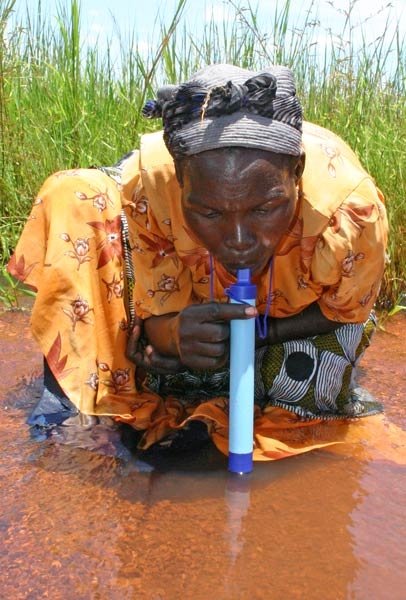
Innovation in aid sector needs ‘room for risk’ | The New Humanitarian
DAKAR
Tea bags, other and text messages have one thing in common: they were each created by chance en route to another solution – the first to transport tea, the second to treat heart disease and the third as an extra phone feature.
Innovations in the humanitarian sector often follow the same pattern – they are not “fixed” or “linear” and depend as much on chance as on political and organizational context, says a report by the Active Learning Network for Accountability and Performance (ALNAP).
Community-based therapeutic feeding, which revolutionized malnutrition treatment, emerged because of another invention – ready-to-use food, such as Plumpy’nut; cash in lieu of food distributions took off in the 2004 tsunami response partly because there was so much cash around.
Research indicates that in addition to chance, there are five steps to successful innovation: recognizing a problem or opportunity; inventing a solution; developing the idea; implementing it; and diffusing it, says ALNAP.
Key ingredients
ALNAP points out innovations in four areas – humanitarian products, such as better cooking stoves; processes, such as stockpiling goods or better quality assurance; positioning, for instance changing from tents to semi-permanent homes for emergency shelter; and paradigms, for example pushing beneficiaries to participate in programming or encouraging local ownership of crisis responses.
“For ideas to take off, organizations need to foster a kind of humanitarian entrepreneurialism,” ALNAP’s head of research and development, Ben Ramalingam, told IRIN. “This requires creative champions to identify and promote innovations; and the institutional courage to accept challenges to existing procedures.”
“And, just as medical innovations are limited by ethical considerations, humanitarian innovation must be built on a principle of ‘honourable risk,’” he added.
World Vision staff were inspired by how airport workers used mobile computing devices to speed up passenger flow, and applied the idea to its emergency programming. They worked with a software firm to develop hand-held technology to scan ration cards reducing the time it takes to identify aid beneficiaries from three minutes to 30 seconds, Jay Narhan, manager of the project, called Last Mile Mobile Solutions, told IRIN. “That observation initiated creative thinking – one good idea sparked another,” he said.
The organization gave its staff clear objectives about what needed improvement, was open to having existing approaches challenged and listened to champions who pushed the idea. “Once out of the gate, it’s a matter of incubating a good idea to garner resources and taking the time to prove its worthiness,” Narhan told IRIN.
Risk
But fear of failure remains high in the humanitarian sector, says ALNAP. “A high-pressured, rapidly changing field operation, often in insecure and dangerous conditions, does not leave much space for trying out ‘new and exciting ideas’ …The consequences of ‘failure’ in a humanitarian situation could be a large-scale loss of human life,” interviewees pointed out. And as the humanitarian sector grows there is an increasing push to maintain order and control, said Peter Walker, director of the Feinstein International Center.
But Tom Corsellis, director of Geneva-based NGO Shelter Centre, told IRIN: “Innovation is happening daily on the ground. It is not the imagination that is the problem; the problem is institutional. You need to sustain the growth of the ‘eureka moment’ and allow it to live.”
Corsellis is pushing for a sector-wide positioning shift to emergency shelter – whereby instead of agencies distributing tents, the current practice, they recognize displaced people require semi-permanent shelter and thus help them access the tools to build it themselves.
At US$500 per construction that lasts on average five years versus $500 for a tent that usually lasts one year, the new approach is more cost-effective and more appropriate for the displaced, said Corsellis.
Corsellis took the idea forward after the 2001 Gujarat earthquake and by the 2004 tsunami most NGOs involved in the shelter sector in Sri Lanka had adopted it. Nevertheless, Ramalingam pointed out, “The position shift has yet to reach critical mass to shift the whole sector.”
Agencies must pool their resources and collaborate rather than compete against each other to achieve sector-wide change, Ramalingam pointed out. “Even in the most cut-throat private industries, there is an increasing awareness of the need to balance competition and collaboration in a a spirit of ‘co-opetition’,” he said.
“Such approaches become especially vital for the most radical innovations, which focus on affected communities, local partnerships and disaster prevention,” he added.
Change is usually incremental and can take years to take hold within one organization and decades to reach others, says ALNAP. The American Red Cross first distributed cash in emergencies in 1871 but it became an accepted norm only in 2004. Ready-to-use therapeutic food has been around since the early 1980s, but was used to transform nutrition interventions only after some 15 years.
Patience is therefore key but some contexts are more fertile breeding grounds for change than others, said Narhan. The need to cut costs and boost efficiency, spurred on by the economic recession, could be just the impetus the sector now needs.
aj/np
Photo Credit:Vestergaard Frandsen/IRIN
This article was produced by IRIN News while it was part of the United Nations Office for the Coordination of Humanitarian Affairs. Please send queries on copyright or liability to the UN. For more information: https://shop.un.org/rights-permissions